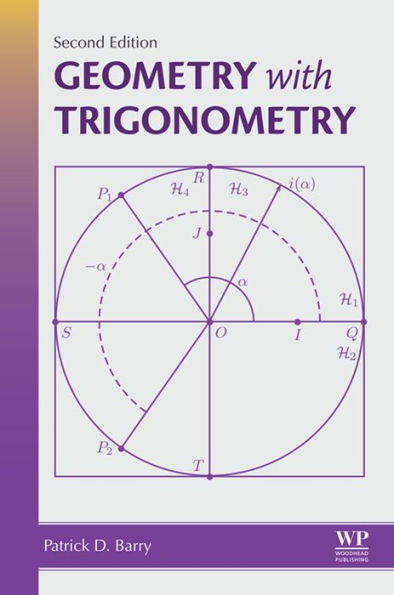Geometry with Trigonometry Second Edition is a second course in plane Euclidean geometry, second in the sense that many of its basic concepts will have been dealt with at school, less precisely. It gets underway with a large section of pure geometry in Chapters 2 to 5 inclusive, in which many familiar results are efficiently proved, although the logical frame work is not traditional. In Chapter 6 there is a convenient introduction of coordinate geometry in which the only use of angles is to handle the perpendicularity or parallelism of lines. Cartesian equations and parametric equations of a line are developed and there are several applications. In Chapter 7 basic properties of circles are developed, the mid-line of an angle-support, and sensed distances. In the short Chaper 8 there is a treatment of translations, axial symmetries and more generally isometries. In Chapter 9 trigonometry is dealt with in an original way which e.g. allows concepts such as clockwise and anticlockwise to be handled in a way which is not purely visual. By the stage of Chapter 9 we have a context in which calculus can be developed. In Chapter 10 the use of complex numbers as coordinates is introduced and the great conveniences this notation allows are systematically exploited. Many and varied topics are dealt with , including sensed angles, sensed area of a triangle, angles between lines as opposed to angles between co-initial half-lines (duo-angles). In Chapter 11 various convenient methods of proving geometrical results are established, position vectors, areal coordinates, an original concept mobile coordinates. In Chapter 12 trigonometric functions in the context of calculus are treated.
New to this edition:
- The second edition has been comprehensively revised over three years
- Errors have been corrected and some proofs marginally improved
- The substantial difference is that Chapter 11 has been significantly extended, particularly the role of mobile coordinates, and a more thorough account of the material is given
- Provides a modern and coherent exposition of geometry with trigonometry for many audiences across mathematics
- Provides many geometric diagrams for a clear understanding of the text and includes problem exercises for many chapters
- Generalizations of this material, such as to solid euclidean geometry and conic sections, when combined with calculus, would lead to applications in science, engineering, and elsewhere
Geometry with Trigonometry Second Edition is a second course in plane Euclidean geometry, second in the sense that many of its basic concepts will have been dealt with at school, less precisely. It gets underway with a large section of pure geometry in Chapters 2 to 5 inclusive, in which many familiar results are efficiently proved, although the logical frame work is not traditional. In Chapter 6 there is a convenient introduction of coordinate geometry in which the only use of angles is to handle the perpendicularity or parallelism of lines. Cartesian equations and parametric equations of a line are developed and there are several applications. In Chapter 7 basic properties of circles are developed, the mid-line of an angle-support, and sensed distances. In the short Chaper 8 there is a treatment of translations, axial symmetries and more generally isometries. In Chapter 9 trigonometry is dealt with in an original way which e.g. allows concepts such as clockwise and anticlockwise to be handled in a way which is not purely visual. By the stage of Chapter 9 we have a context in which calculus can be developed. In Chapter 10 the use of complex numbers as coordinates is introduced and the great conveniences this notation allows are systematically exploited. Many and varied topics are dealt with , including sensed angles, sensed area of a triangle, angles between lines as opposed to angles between co-initial half-lines (duo-angles). In Chapter 11 various convenient methods of proving geometrical results are established, position vectors, areal coordinates, an original concept mobile coordinates. In Chapter 12 trigonometric functions in the context of calculus are treated.
New to this edition:
- The second edition has been comprehensively revised over three years
- Errors have been corrected and some proofs marginally improved
- The substantial difference is that Chapter 11 has been significantly extended, particularly the role of mobile coordinates, and a more thorough account of the material is given
- Provides a modern and coherent exposition of geometry with trigonometry for many audiences across mathematics
- Provides many geometric diagrams for a clear understanding of the text and includes problem exercises for many chapters
- Generalizations of this material, such as to solid euclidean geometry and conic sections, when combined with calculus, would lead to applications in science, engineering, and elsewhere

Geometry with Trigonometry
280
Geometry with Trigonometry
280eBook
Related collections and offers

Product Details
| ISBN-13: | 9780128050675 |
|---|---|
| Publisher: | Elsevier Science |
| Publication date: | 12/24/2015 |
| Sold by: | Barnes & Noble |
| Format: | eBook |
| Pages: | 280 |
| File size: | 8 MB |
